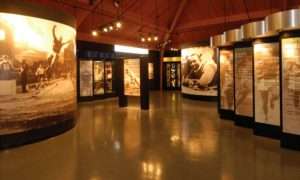The mound complex known as the Oakville Indian Mounds was the heart of a large cultural center that dominated this section of the Moulton Valley along Flint Creek and its tributaries from AD 1 to 500 during the Middle Woodland period. Oakville is one of three sites that features a Middle Woodland platform mound in the Middle Tennessee Valley. Five mounds were reported at Oakville when Gerard Fowke from the Bureau of American Ethnology documented the site in 1926. Since that time, three of the mounds have been completely destroyed through agricultural practices.
The two mounds that remain represent two different types of earthen structures: the 8 meter high square platform mound is one of the largest platform mounds in the state of Alabama, and the other is a smaller 4 meter high conical burial mound. Excavations at other early platform mounds suggest that Oakville’s platform mound was a place where people would come together to hold ceremonies, exchange exotic goods, and renew social ties. The burial mound was built exclusively to inter elite members of the society. In the 1840s, American settlers established the “Old Settler Cemetery” on top of the burial mound.
The Oakville Indian Mounds were built by people belonging to what has been termed the Copena Mortuary Complex. The Copena people were associated with the larger Hopewell cultural group whose influence extended well beyond the Moulton and Tennessee River Valleys to the Ohio River Valley and surrounding regions. These people brought materials from as far away as the Appalachian Mountains of North Carolina to the western end of the Tennessee Valley to the Great Lakes.
“Copena” derives its name from the combination of two words for items commonly found in Copena sites: copper and galena (lead sulfide). Copper likely traded from the upper Midwest and galena from the Upper Mississippi Valley in the area of Wisconsin, Illinois, and Iowa. These raw materials were traded extensively and were often buried with the dead as part of an elaborate ceremony.
This site is very important to numerous Southeastern indigenous tribes who assert an ancestral connection with those who built and occupied Alabama’s ancient mounds. The earthwork landscapes and the objects and information recovered from them reveal a rich cultural tradition that still thrives today among these tribes. Our indigenous mound sites represent a heritage for all Alabamians to cherish, and it is important that we protect and preserve them for future generations.
Located in Lawrence County.

Jesse Owens Museum
Dedicated June, 1996 with the arrival of the Olympic Torch enroute to the Atlanta Games, The Jesse Owens Museum & Park is a tribute to the life an
